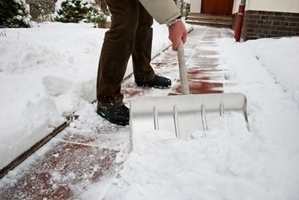While the holiday season is the most wonderful time of the year, the weather and slippery conditions make it a dangerous time for many people, especially seniors. People in travel therapy jobs may see an influx of senior patients with slip and fall injuries when conditions start getting dangerous, but there are things people can do to limit their chances of getting injured this winter. Here are some of the most common wintertime injuries for seniors, indoors and outdoors, and how they can stay safe:
Back injuries
There are a lot of ways you can hurt yourself while shoveling snow. Not only is the activity strenuous on your heart, but it's also rough on your body. This is especially true for seniors who have osteoporosis. One of the most common injuries, however, are are those that occur to the back from either the repetitive motion of shoveling or attempting to lift a load of snow that's too heavy. If you insist on shoveling your own walk, take it easy, and don't overwork yourself. If you suspect that you've strained a muscle or your back begins to hurt, cease shoveling for the day and warm up indoors. Chances are, there is a neighborhood kid who would love to shovel your walk for you for a couple of bucks!
Falls
According to Learn Not to Fall, falls are the leading cause of injury-related death in seniors, with approximately 87 percent of fractures sustained by elderly people can be attributed to this type of incident. Since anyone who walks on a slippery sidewalk in the winter is vulnerable to falling, it's important for seniors to take special care since the ailments associated with falling, like broken bones and head injuries, are so much more dangerous for the older population. To avoid slipping, wear shoes with proper tread, and wear slippers on hardwood floors instead of just your socks. If you use a cane, make sure the tip is in good condition. When you enter the house, take your shoes off right away so you don't track snow indoors, potentially causing a fall later on.
Hypothermia
While anyone is at risk for hypothermia when they spend a lot time in cold winter temperatures, older people's risk is a bit higher. This is because seniors produce less body heat, according to the Crittenton Hospital. This paired with the fact that many seniors don't shiver – one of the first indicators of hypothermia – can make it difficult to tell when the cold air gets to be too much. If you plan to be outdoors for long periods of time, whether you're visiting a winter fair or putting up Christmas decoration, make sure you dress appropriately. Wear multiple warm layers, and pay attention to your body. If you begin feeling weak and your skin begins to look pale or ashy, go inside and warm up.
Car accidents
When the roads get icy, there are more traffic accidents in all age groups. However, as you age, your reaction time may not be what it once was. This could contribute to anything from a minor fender bender to a serious collision. Make your car as safe as possible by equipping it with snow tires, as well as keeping an arsenal of cold-weather products like blankets, a shovel and salt or kitty litter in your trunk. While minor accidents may not cause anyone to get hurt, people in travel therapy jobs may find that they are helping people to recover from car accident injuries, like strained muscles or whiplash, this winter.

